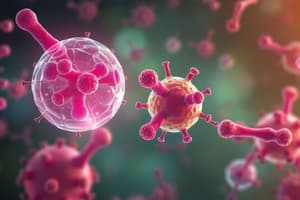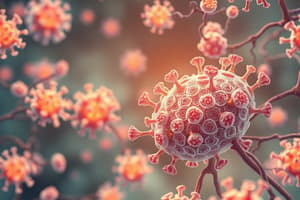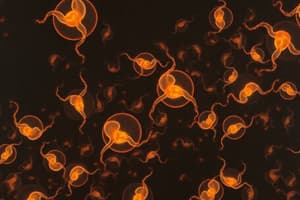Podcast
Questions and Answers
[Blank] immunity involves antibodies circulating in the body's fluids such as blood and lymph.
[Blank] immunity involves antibodies circulating in the body's fluids such as blood and lymph.
Humoral
[Blank] immunity involves lymphocytes that defend the body.
[Blank] immunity involves lymphocytes that defend the body.
Cellular
Unlike innate defense, adaptive defenses are ______, recognizing and targeting specific antigens.
Unlike innate defense, adaptive defenses are ______, recognizing and targeting specific antigens.
specific
An advantage of adaptive defenses is that they have ______, allowing for a stronger response to successive encounters of the same antigen.
An advantage of adaptive defenses is that they have ______, allowing for a stronger response to successive encounters of the same antigen.
[Blank] are substances that provoke an immune response because they are recognized as ‘non-self’.
[Blank] are substances that provoke an immune response because they are recognized as ‘non-self’.
[Blank] proteins, found on all nucleated cells in the body, are involved in self-recognition.
[Blank] proteins, found on all nucleated cells in the body, are involved in self-recognition.
[Blank] have antigenic determinants where antibodies or lymphocyte receptors bind to.
[Blank] have antigenic determinants where antibodies or lymphocyte receptors bind to.
The primary lymphoid organs where lymphocytes become immunocompetent are the bone marrow for B cells and the ______ for T cells.
The primary lymphoid organs where lymphocytes become immunocompetent are the bone marrow for B cells and the ______ for T cells.
The type of cell that clone cells differentiate into and that secrete antibodies into plasma is called ______ cells.
The type of cell that clone cells differentiate into and that secrete antibodies into plasma is called ______ cells.
If memory cells are re-exposed to the same antigen, the immune response is classified as ______.
If memory cells are re-exposed to the same antigen, the immune response is classified as ______.
In active humoral immunity, the key result is the creation of ______ B cells.
In active humoral immunity, the key result is the creation of ______ B cells.
Ready-made antibodies being introduced to the body characterizes ______ humoral immunity.
Ready-made antibodies being introduced to the body characterizes ______ humoral immunity.
[Blank], also known as Immunoglobulins, are generated by plasma cells in order to respond to an antigen
[Blank], also known as Immunoglobulins, are generated by plasma cells in order to respond to an antigen
An antibodies monomer is essentially linked polypeptide chains, which can further be categorized into two ______ and light.
An antibodies monomer is essentially linked polypeptide chains, which can further be categorized into two ______ and light.
Regions known as ______ of H and L chains combine to form an antigen binding site
Regions known as ______ of H and L chains combine to form an antigen binding site
IgD, IgG, & IgE all operate as ______
IgD, IgG, & IgE all operate as ______
A main goal of antibodies is to inactivate antigens and tag them for ______
A main goal of antibodies is to inactivate antigens and tag them for ______
[Blank] can be considered as antibody-mediated immunity
[Blank] can be considered as antibody-mediated immunity
On the contrary, [Blank] can be considered cell-mediated immunity.
On the contrary, [Blank] can be considered cell-mediated immunity.
[Blank] are substances that can provoke an immune response
[Blank] are substances that can provoke an immune response
[Blank] cells directly kill body cells that are infected by viruses or bacteria, cancerous or abnormal and that are foreign/ transplanted cells
[Blank] cells directly kill body cells that are infected by viruses or bacteria, cancerous or abnormal and that are foreign/ transplanted cells
[Blank] cells release chemicals help activate TC cells and B cells
[Blank] cells release chemicals help activate TC cells and B cells
[Blank] have MHC class II proteins on cell surfaces
[Blank] have MHC class II proteins on cell surfaces
[Blank] release Interleukin-1, which stimulates TH cells to release Interleukin 2
[Blank] release Interleukin-1, which stimulates TH cells to release Interleukin 2
After recognizing a target, TC's release ______ & granzymes
After recognizing a target, TC's release ______ & granzymes
In Organ transplants, tissues are aimed to be the same to ensure that ______ cells, NK cells and antibodies do not attack the new organ
In Organ transplants, tissues are aimed to be the same to ensure that ______ cells, NK cells and antibodies do not attack the new organ
Immunodeficiencies are formed when immune cells and/or ______ behave abnormally
Immunodeficiencies are formed when immune cells and/or ______ behave abnormally
Autoimmune diseases stem from a loss of ability to distinguish ______ from non self.
Autoimmune diseases stem from a loss of ability to distinguish ______ from non self.
Helper T cells help ______ cells to attack infected cells.
Helper T cells help ______ cells to attack infected cells.
Helper T cells help [______lank] cells signal antibody production
Helper T cells help [______lank] cells signal antibody production
Flashcards
Humoral Immunity
Humoral Immunity
Immunity mediated by antibodies circulating in body fluids, targeting extracellular pathogens.
Cellular Immunity
Cellular Immunity
Immunity where lymphocytes directly defend the body, targeting cellular level threats.
Innate Immunity
Innate Immunity
Fast and nonspecific defense mechanism functioning like guards checking IDs
Adaptive Immunity
Adaptive Immunity
Signup and view all the flashcards
Antigens
Antigens
Signup and view all the flashcards
MHC Class I Proteins
MHC Class I Proteins
Signup and view all the flashcards
MHC Class II Proteins
MHC Class II Proteins
Signup and view all the flashcards
Antigenic Determinants
Antigenic Determinants
Signup and view all the flashcards
Immunocompetence
Immunocompetence
Signup and view all the flashcards
Antibody-Mediated Immunity
Antibody-Mediated Immunity
Signup and view all the flashcards
B-Cell Cloning
B-Cell Cloning
Signup and view all the flashcards
Plasma Cells
Plasma Cells
Signup and view all the flashcards
Memory Cells
Memory Cells
Signup and view all the flashcards
Primary Immune Response
Primary Immune Response
Signup and view all the flashcards
Secondary Immune Response
Secondary Immune Response
Signup and view all the flashcards
Active Immunity
Active Immunity
Signup and view all the flashcards
Passive Immunity
Passive Immunity
Signup and view all the flashcards
Immunoglobulins (Igs)
Immunoglobulins (Igs)
Signup and view all the flashcards
Antibody Functions
Antibody Functions
Signup and view all the flashcards
Cytotoxic T cells (TC)
Cytotoxic T cells (TC)
Signup and view all the flashcards
Helper T cells (TH)
Helper T cells (TH)
Signup and view all the flashcards
Antigen-presenting cells (APCs)
Antigen-presenting cells (APCs)
Signup and view all the flashcards
Double recognition
Double recognition
Signup and view all the flashcards
Helper T cells (TH)
Helper T cells (TH)
Signup and view all the flashcards
Study Notes
- Adaptive defenses are reviewed and compared with innate defenses in this lecture.
- The roles of B and T lymphocytes, antigens, and antigen-presenting cells in adaptive immunity are also examined.
Lecture Goals
- Understand the difference between humoral and cellular immunity and know which cells are responsible for each.
- Know what antigens are, why they are important, and how the body recognizes self versus non-self.
- Know the steps of the immunocompetent cycle.
- Understand the steps involved in humoral immunity and B-cell cloning.
- Understand the different types of humoral immunity, including active vs. passive and natural vs. artificially acquired.
- Describe structure of an immunoglobulin (Ig), know the different classes of Igs, and explain how they differ.
- Understand the mechanisms of how antibodies work and the strategies employed to destroy antigens once bound.
- Understand the mechanisms of how antigen-presenting cells (APCs) operate.
- Understand the mechanisms of how cytotoxic and helper T cells operate.
Overview of Adaptive Immunity
- Adaptive immunity requires priming before it can take effect.
- In the 1800s, experiments showed that animals surviving bacterial infections developed protective factors in their blood to defend against future attacks by the same pathogen.
- Serum containing antibodies can protect other animals not previously exposed.
- Injecting lymphocytes also offered protection.
Types of Adaptive Immunity
- Humoral immunity involves antibodies produced from lymphocytes that circulate in the body's fluids (blood, lymph).
- This targets extracellular pathogens such as bacteria, toxins, and free viruses with B cells.
- Cellular immunity involves lymphocytes directly defending the body.
- This targets cellular pathogens such as cells infected with pathogens, cancer cells, and foreign graft cells with T cells.
Adaptive vs. Innate Immunity
- Adaptive defenses uses B and T lymphocytes, whereas innate defenses involves diverse cells, processes, and structures like NK cells, phagocytes, antimicrobial proteins, inflammatory chemicals, and physical barriers.
- Adaptive immunity is specific, recognizing and targeting identified pathogens or foreign substances like antigens, while innate immunity is nonspecific in identifying friend or foe.
- Adaptive immunity is slow to mobilize, while innate immunity is fast and always ready.
- Adaptive immunity has memory, reacting strongly to successive encounters of the same antigen, whereas innate immunity usually has no memory.
- Adaptive immunity is systemic (body-wide) and not restricted to the initial infection site, while innate immunity is largely restricted to the initial infection site, except for fever.
Antigens
- Antigens are substances that can provoke an immune response, including any foreign cells.
- Antigens not normally present in the body are recognized as 'non-self,' triggering an immune response.
- Self-recognition/self-antigens are molecules on the surface of cells.
- Major histocompatibility complex (MHC) class I proteins are found on all nucleated cells in the body.
- MHC class II proteins are found on antigen-presenting cells.
- Antigens have "antigenic determinants" where antibodies or lymphocyte receptors bind.
Immunocompetence of Lymphocytes
- Before lymphocytes can respond to antigens, they must become immunocompetent.
- Lymphocytes (B cells, T cells) originate from red bone marrow.
- B and T cells mature in primary lymphoid organs, displaying receptors that can recognize antigens, which makes them immunocompetent.
- B cells mature in the bone marrow.
- T cells mature in the thymus.
- Lymphocytes circulate in blood and secondary lymphoid organs.
Humoral Immune Response (B-Cell Cloning)
- Immunocompetent B-cells encounter and bind to antigens.
- B-cells clone themselves.
- Most clone cells differentiate into plasma cells (effector B cells), but some clone cells become memory cells.
- Plasma cells secrete antibodies into plasma during the primary immune response, where antibody levels peak around day 10.
- If memory cells are re-exposed to the same antigen later, a secondary immune response occurs, which is more rapid, larger, and prolonged.
Humoral Response
- The first exposure to an antigen is the primary immune response.
- Antibody production begins in about 3-6 days, with antibody levels peaking around day 10.
- The second exposure to the same antigen induces a secondary immune response.
- The secondary immune response is faster, larger, and more prolonged.
Types of Humoral Immunity
- Active humoral immunity can be either naturally or artificially acquired.
- Occurs through infection or vaccination.
- Both result in the formation of memory B cells and provide long-term protection.
- Passive humoral immunity can be either naturally or artificially acquired.
- Occurs through antibodies passed from mother to fetus or infant, or injection of gamma globulin.
- Ready-made antibodies are introduced into the body and do not create memory B cells.
- Provides short-term protection where protection from the mother lasts several months, while exogenous antibodies last weeks.
Antibodies (Immunoglobulins or Igs)
- Antibodies are secreted by plasma cells (effector B cells) in response to an antigen.
- An antibody monomer has four polypeptide chains linked by disulfide bonds, forming a T or Y shape.
- Includes 2 heavy (H) chains and 2 light (L) chains.
- C (constant) region.
- V (variable) region.
- The V regions of H and L chains combine to form two antigen-binding sites in a monomer.
Antibody Classes
- Include 5 major classes IgD, IgG, IgE, IgA, and IgM
- IgD, IgG, and IgE are monomers, IgA is a dimer, and IgM is a pentamer.
- Dimers have 4 antigen-binding sites, and pentamers have 10.
Antibody Functions
- Antibodies inactivate antigens and tag them for destruction.
- Strategies to achieve this include:
- Neutralization: Blocking the harmful effects of the antigen.
- Agglutination: Clumping together antigen particles.
- Precipitation: Making soluble antigens insoluble.
- Complement activation: Triggering the complement system to enhance phagocytosis or cell lysis.
Cellular Immunity: T Lymphocytes (T cells)
- Two types of T cells exist including helper T and cytotoxic T.
- Cytotoxic T cells (TC) directly kill body cells that are infected by viruses or bacteria, cancerous or abnormal, or foreign (transplanted cells).
- Helper T cells (TH) release chemicals that help activate TC cells and B cells.
Cellular Immunity: Antigen-Presenting Cells (APCs)
- APCs have MHC class II proteins on their cell surfaces.
- APCs engulf antigens and present fragments to T-cells to initiate an immune response.
- Examples of APCs include dendritic cells, macrophages, and B cells.
T-Cell Activation
- T-cells activate by double recognition, where they must recognize both the foreign antigen displayed and self (MHC I or MHC II).
- TH cells bind to antigens on APCs and also recognize self (MHC II).
- TC cells bind to antigens on body cells and also recognize self (MHC class I proteins).
Cellular Immunity: Helper T cells (TH)
- TH cells bind to antigens on APCs and also recognize self (MHC II).
- Macrophages release interleukin-1, which stimulates TH cells to release interleukin-2 (IL-2).
- IL-2 stimulates the activation and proliferation of TC and B cells. -TC cells then attack infected cells. -B cells engage in antibody production.
Cellular Immunity: Cytotoxic T cells (TC)
- Infected/cancerous cells display abnormal antigens.
- TC cells bind to abnormal antigens on body cells and also recognize self (MHC class I proteins).
- TC cells release perforins and granzymes to kill off infected cells after recognizing the target.
Clinical Connections
- Organ transplants require tissue similarity to prevent T cells, NK cells, and antibodies from attacking the new organ, often involving immunosuppressive and anti-inflammatory drugs.
- Immunodeficiencies result in immune cells and/or antibodies behaving abnormally.
- Autoimmune diseases involve a loss of ability to distinguish self from non-self, leading the body to produce antibodies against its own cells.
- In HIV/AIDS, helper T (TH) cells are destroyed. -Multiple Sclerosis (MS) destroys the white matter of the brain and spinal cord. -Type-1 diabetes destroys pancreatic cells that produce insulin.
Studying That Suits You
Use AI to generate personalized quizzes and flashcards to suit your learning preferences.




